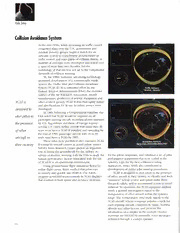Table Of ContentPublic Safety
CoIEii Avoo&nce System
In the mid-1950s, when increasing air traffic caused
congested skies over the U.S., government and
aviation industry groups began a search for an
airborne system to complement ground-based air
traffic control and warn pilots of collision threats. A
number of concepts were developed and tested over
a span of more than two decades, but the
technology of that era was not up to the complicated
demands of collision warning.
By the 1980s, however, advancing technology
permitted development of a commercially viable
system, the Traffic Alert and Collision Avoidance
System (TCAS 11). In a concerted effort by the
Federal Aviation Administration (FAA), the member
airlines of the Air Transport Association, aircraft
manufacturers, producers of avionic equipment and
T a si s other aviation groups, TCAS I1 was thoroughly tested
and specifications for its use in airline service were
designed to developed.
In 1989, following a Congressional mandate, the
alertpilots to FAA ruled that TCAS would be required on all
passenger carrying aircraft, including planes operated
thepresence by U.S. flag airlines and those of foreign registry
serving U.S. cities. Airline aircraft with more than 30
of other seats must have a TCAS I1 installed and operating by
the end of 193; passenger aircraft with 10 to 30
aircraft in seats must have a TCAS by 195.
These rules were published after extensive TCAS
their vicinity I1 testing by several carriers in actual airline service.
NASA's Ames Research Center played an important
role in laying the groundwork for the airlines' in-
service evaluation, teaming with the FAA to study the for the pilots' responses, and validated a set of pilot
human performance factors associated with the use performance parameters that were coded in the
of TCAS I1 in an operational environment. system's logic for the best collision-evading
Using ground-based flight simulators flown by maneuvers. Ames' work also contributed to
airline flight crews, Ames verified that pilots can development of airline pilot training procedures.
accurately and quickly use TCAS 11. The NASA TCAS is designed to alert pilots to the presence
program generated improvements in TCAS displays of other aircraft in their vicinity, to identlfy and track
that resulted in both speed and accuracy increases "intruders" whose course and speed make them
threats to safety, and to recommend action to avoid
collision. In operation, the TCAS-equipped airplane
sends a general interrogation signal to the
transponders of other aircraft within the system's
range. The transponders send reply signals to the
TCAS aircraft, whose computer initiates a track for
each replying aircraft, computes its range, bearing,
altitude and other factors, and presents this
information on a display in the cockpit. Display
warnings are backed by automatic voice messages
delivered through a cockpit speaker.
vertical speed indicator on his display, on which
TCAS I1 has colored a portion of the dial red and
green. The pilot must maneuver the airplane so that
the needle moves out of the red area into the green
target area; in this instance he must descend at 1,500
feet per minute.
The illustration at left shows his maneuver
successful; there is now 600 feet of vertical
separation between the two aircraft. Below, TCAS I1
indicates - by changing the intruder's symbol back
to a yellow circle - that the crisis has passed; the
voice message confis "Clear of conflict."
Ames Research Center conducted three
laboratory experiments to determine pilots'
performance in responding to TCAS advisories.
From the first study, Ames concludes that pilots were
able to use TCAS I1 correctly within the allowable NASA studies
five-second response time and that TCAS was
effective in reducing the severity of simulated contributed
conflicts.
In the second experiment, Ames tested pilots' signzjkantly
responses to changes in the avoidance advisories, for
example, a second Resolution Advisory commanding to the
an increase in the earlier-recommended climb or
descent rate. Recorded reaction times suggested that airlines'
pilots are able to respond to these changes within
the targeted two seconds. evaluation of
In the thud experiment, pilot reactions to
alternative TCAS displays were examined. For TCAS II and
example, the vertical speed indicator was modified
to include a green-lighted target vertical speed rate in to improved
A display unit shows the TCAS aircraft as the addition to the red-lighted area. The results showed
center of the local airspace volume and indicates pilot preference to the red-and-green display over air tragic
intruders in that airspace, as shown at upper left. the red-only display and the TCAS I1 was changed
Here an intruder has come close enough to trigger a accordingly. These studies contributed significantly to system safety
Traffic Advisory. The computer changes the the airlines' evaluation of TCAS I1 and to improved
intruder's display symbol, previously a white air traffic system safety.
diamond (non-threat) to a yellow circle (potential
threat); the +03 adjacent to the circle means that the
intruder is 300 feet higher than the TCAS aircraft.
Simultaneously with the appearance of the yellow
circle, the pilot hears the vocal Tfic Advisory
''Traffic, traffic."
At lower left, the intruder has moved closer on
a collision course and passed the inner ring on the
display; it is now a definite collision threat. TCAS I1
issues a Resolution Advisory; it changes the intruder's
symbol to red and the cockpit speaker delivers a
vocal message announcing the required evasive
action: "Descend, descend, descend." To find out
how rapidly he must descend, the pilot consults the

